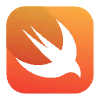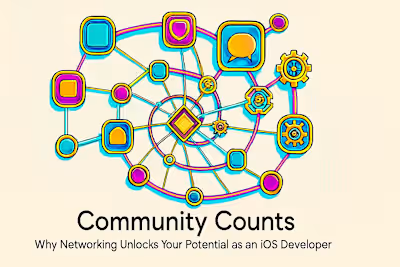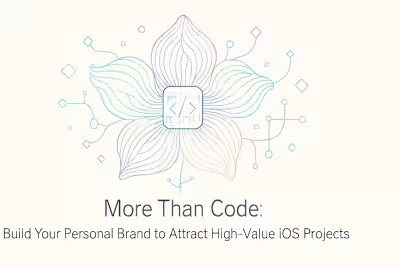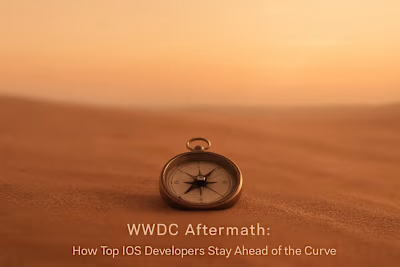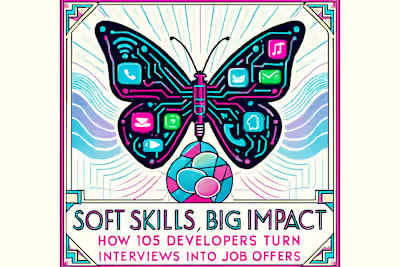Follow Up Like a Pro: The iOS Developer's Guide to Post-Interview Success
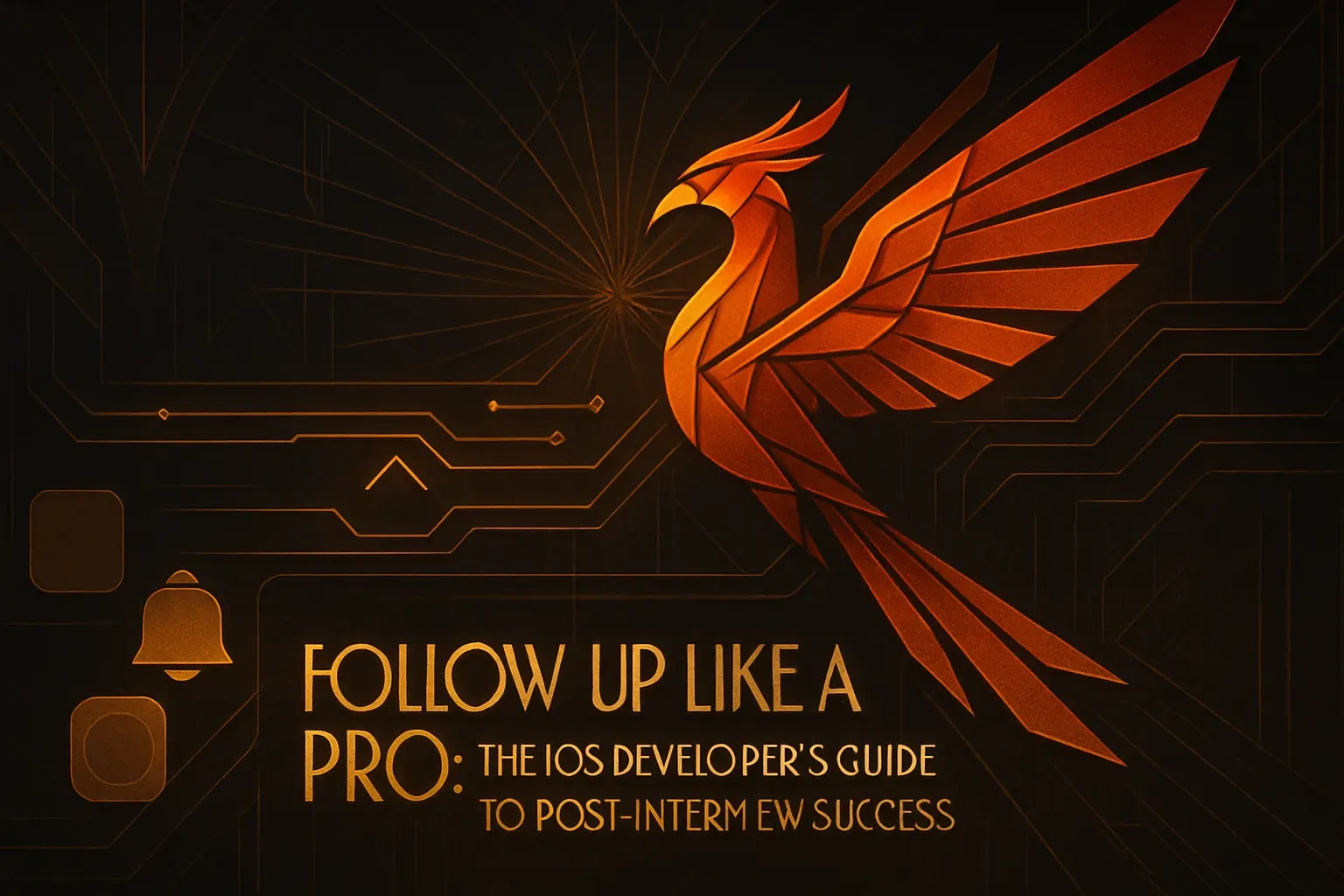
Follow Up Like a Pro: The iOS Developer's Guide to Post-Interview Success
The Art of the Thank-You Email
Perfect Timing: The 24-Hour Rule
Key Components of a Memorable Note
Template and Customization Tips
Navigating the Waiting Game
Respecting Their Timeline
The Gentle Nudge: A Follow-Up Template
You Got the Offer! Now What?
Expressing Gratitude and Next Steps
The Art of Negotiation
Handling Rejection with Grace
Asking for Feedback
Maintaining the Relationship
Conclusion
References
Follow Up Like a Pro: The iOS Developer's Guide to Post-Interview Success
You've navigated the technical questions and showcased your soft skills. The hard part is over, right? Not quite. The post-interview follow-up is a critical, often overlooked, stage where you can solidify a positive impression and significantly increase your chances of receiving an offer. A strategic follow-up demonstrates professionalism, enthusiasm, and attention to detail—all key traits clients want when they hire iOS developers.
This guide provides a complete playbook for the post-interview process, from crafting the perfect thank-you note to gracefully handling the final outcome. Whether you're interviewing for a freelance gig or a full-time position, the way you handle yourself after you've showcased your soft skills can make the difference between landing the job and being forgotten.
The Art of the Thank-You Email
A well-crafted thank-you email is non-negotiable. It's your first opportunity after the interview to reconnect with the hiring manager and reiterate your value. Think of it as your chance to leave one final, polished impression that sets you apart from other candidates.
Many developers skip this step, thinking their technical skills speak for themselves. But here's the thing: when multiple candidates have similar technical abilities, it's often the small gestures that tip the scales. A thoughtful thank-you note shows you're not just a skilled coder—you're a professional who understands business etiquette.
Perfect Timing: The 24-Hour Rule
Timing is everything when it comes to follow-up emails. Aim to send your thank-you email within 24 hours of the interview. This ensures the conversation is still fresh in the interviewer's mind and shows you are prompt and organized.
Why 24 hours? It's the sweet spot. Send it too soon (within a couple hours), and you might seem overeager or like you're using a generic template. Wait too long (more than 48 hours), and the interviewer might have already moved on to other candidates. The 24-hour window gives you time to craft a thoughtful message while keeping your candidacy top of mind.
Set a reminder on your phone right after the interview. When you get home, jot down some notes about what you discussed while it's fresh. Then, the next morning, use those notes to write your email. This approach ensures your message feels authentic and specific rather than rushed.
Key Components of a Memorable Note
Your email should be more than just "Thanks for your time." A memorable thank-you note has three essential components that work together to reinforce your candidacy.
First, include a personalized reference to something specific you discussed. Maybe you talked about their upcoming Swift migration, or perhaps you bonded over a shared interest in accessibility features. Whatever it was, mentioning it shows you were engaged and paying attention.
Second, reiterate your excitement for the role. But don't just say you're excited—explain why. Connect it to your career goals or mention how the company's mission aligns with your values. For example: "Our discussion about your team's focus on creating inclusive apps really resonated with me, as accessibility has been a passion project of mine for the past two years."
Third, include one final mention of how your skills align with their needs. This isn't the time for a full pitch, but a subtle reminder works well. Something like: "I'm confident my experience optimizing app performance for millions of users at my previous role would help your team tackle the scaling challenges you mentioned."
Template and Customization Tips
Here's a simple template to get you started:
The key is customization. If you met with multiple people, each should receive a unique email. Your note to the engineering manager might focus on technical challenges, while your email to the product manager could emphasize your experience collaborating on user-focused features.
Keep each email concise—aim for 150-200 words. Remember to proofread carefully. A typo in a thank-you note can undo all your good work in the interview.
Navigating the Waiting Game
The silence after an interview can be stressful. You sent your thank-you note, and now... nothing. Days pass, and you start second-guessing every answer you gave. Did you talk too much about that one project? Should you have asked different questions?
This waiting period tests your patience, but it's also an opportunity to demonstrate professionalism. Knowing when and how to follow up again without being pushy is a delicate balance that showcases your communication skills.
Respecting Their Timeline
If the interviewer gave you a timeline, respect it. Period. When they say "We'll be in touch by the end of next week," that means don't follow up before then. Mark your calendar and wait.
Why is this so important? Hiring processes often involve multiple stakeholders. The person who interviewed you might need to discuss candidates with their team, check references, or wait for budget approval. Following up too early makes you seem impatient or like you weren't listening when they explained their process.
If no timeline was given, wait about a week before sending a brief check-in. This gives them reasonable time to move through their process without leaving you hanging indefinitely. Some companies move fast, others take weeks—a one-week follow-up strikes the right balance.
During this waiting period, resist the urge to stalk the interviewer on LinkedIn or check if they've viewed your profile. Focus instead on continuing your job search. Even if this opportunity feels perfect, keeping momentum with other applications prevents you from putting all your eggs in one basket.
The Gentle Nudge: A Follow-Up Template
When it's time for that follow-up, keep it brief and professional. Here's a template that works:
That's it. No need to rehash your qualifications or add pressure. The message accomplishes three things: it politely reminds them of your candidacy, reaffirms your interest, and opens the door for communication.
If you don't hear back after this follow-up, wait another week and send one final check-in. After that, it's best to move on. Some companies ghost candidates—it's unprofessional, but it happens. Don't take it personally, and don't burn bridges with angry emails.
You Got the Offer! Now What?
Congratulations! Receiving an offer is a fantastic achievement. All those hours perfecting your portfolio, practicing algorithms, and preparing for interviews have paid off. But don't pop the champagne just yet—how you handle the offer stage is crucial for starting the engagement on the right foot.
Your first instinct might be to immediately accept, especially if you've been job hunting for a while. But taking a measured approach ensures you fully understand what you're agreeing to and sets a professional tone for your future relationship.
Expressing Gratitude and Next Steps
Your initial response should balance enthusiasm with professionalism. When you receive the offer—whether by phone or email—express genuine gratitude and excitement. But don't commit on the spot.
Here's how to respond:
"Thank you so much for the offer! I'm thrilled about the opportunity to join your team. I'd like to review the full details of the offer. Could you please send the offer letter so I can look everything over? When would you need my response by?"
This response accomplishes several things. It shows you're excited (which they want to hear), demonstrates professionalism by requesting written documentation, and establishes a timeline for your decision.
Always get the offer in writing before making any commitments. Verbal offers can change or be misunderstood. The written offer should include:
Compensation details (salary/rate, bonuses, equity if applicable)
Start date and work schedule
Benefits package (for full-time roles)
Job responsibilities and reporting structure
Any conditions (background checks, references)
For freelance positions, ensure the contract specifies project scope, deliverables, payment terms, and intellectual property agreements. Don't assume anything—if it's not in writing, it's not part of the deal.
The Art of Negotiation
Negotiation isn't about being greedy or difficult. It's about ensuring the arrangement works well for both parties. Most employers expect some negotiation—in fact, not negotiating can sometimes be seen as a lack of confidence.
For freelancers, negotiation typically focuses on three areas:
Rate: Research market rates for iOS developers with your experience level. Sites like Glassdoor or salary surveys from iOS developer communities provide benchmarks. If their offer is below market, present your research professionally: "Based on my research and experience level, I was expecting a rate closer to $X. Can we discuss this?"
Scope: Ensure the project scope is crystal clear. Vague requirements lead to scope creep. Ask questions like: "Does this include app store submission?" or "How many rounds of revisions are included?"
Payment terms: Don't be shy about discussing when and how you'll be paid. Net 30 might be standard, but as a freelancer, you can often negotiate partial upfront payment or milestone-based payments.
For full-time positions, consider the entire package:
Base salary: This is usually the most flexible component. If they can't meet your salary expectations, ask about signing bonuses or performance bonuses.
Benefits: Sometimes benefits are non-negotiable, but you might be able to negotiate additional PTO days or professional development budgets.
Flexibility: Remote work options, flexible hours, or the ability to work on open-source projects can be valuable negotiation points.
Start date: If you need time off for a pre-planned trip or want a break between jobs, negotiate your start date upfront.
Remember, negotiation is a conversation, not a confrontation. Use phrases like "I'm wondering if there's flexibility on..." or "Would you be open to discussing..." Keep the tone collaborative and focus on finding win-win solutions.
Handling Rejection with Grace
Not every interview results in an offer. Maybe they went with someone with more experience. Perhaps the role requirements changed. Or maybe it just wasn't the right fit. Whatever the reason, how you handle rejection can leave a lasting positive impression and keep doors open for future opportunities.
Your first reaction might be disappointment, frustration, or even anger—especially if you thought the interview went well. These feelings are normal. Take a day to process them privately. But when you respond to the company, channel your inner professional.
Asking for Feedback
Once you've processed the initial disappointment, send a brief, polite email thanking them for the opportunity and asking if they'd be willing to share feedback. Not all companies will respond, but when they do, the insights can be invaluable.
Here's a template:
If they provide feedback, resist the urge to defend yourself or argue. Thank them for their insights, even if you disagree. Common feedback for iOS developers might include:
Technical gaps: "We needed someone with more SwiftUI experience"
Communication: "We felt you could have explained your technical decisions more clearly"
Culture fit: "We were looking for someone with more startup experience"
Use this feedback constructively. If multiple companies mention the same issue, that's your cue to address it before your next interview.
Maintaining the Relationship
Don't burn bridges. The tech world is smaller than you think, and the person who rejected you today might be your colleague, client, or even manager in the future.
Send a LinkedIn connection request with a personalized note: "Hi [Name], I enjoyed our conversation about iOS development at [Company]. I'd love to stay connected and follow [Company's] journey. Best wishes with the new hire!"
This simple gesture keeps you on their radar for future opportunities. Companies often repost positions when hires don't work out, or they might have similar roles open up later. Your professionalism during rejection might make you their first call.
Continue engaging with their content on LinkedIn if it genuinely interests you. Comment thoughtfully on their technical blog posts or congratulate them on product launches. But keep it professional—don't overdo it or seem like you're desperately trying to get their attention.
Sometimes, rejection leads to unexpected opportunities. That startup that couldn't afford your rate might recommend you to a friend's company. The enterprise that needed someone more senior might reach out when a senior position opens up. By handling rejection gracefully, you transform a "no" into a "not right now."
Conclusion
The interview might be over, but your opportunity to make an impression isn't. Every interaction after the interview—from your thank-you note to how you handle the outcome—shapes how you're remembered.
Master these follow-up skills, and you'll stand out in a sea of technically competent developers. You'll be the one they remember not just for your coding abilities, but for your professionalism, communication skills, and grace under pressure.
Whether you land this particular role or not, each interview cycle makes you stronger. The thank-you notes get easier to write. The waiting becomes less stressful. Negotiations feel more natural. And even rejections become learning opportunities rather than setbacks.
Your next iOS development opportunity is out there. By following up like a pro, you're not just improving your chances for this role—you're building a reputation that will serve you throughout your career. Now go write that thank-you note. Your future self will thank you.
References
Like this project
Posted Jul 6, 2025
The interview isn't over when you walk out the door. Learn how to write the perfect follow-up email, navigate the waiting period, and handle the final offer to seal the deal.


